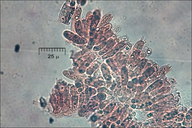date of photo Oct 19, 2014
latitude 46.36029 longitude 13.70264
View on Google Maps.
location
Lower Trenta valley, right banks of river Soča, in front of Trenta 2b cottage, East Julian Alps (Posočje, Slovenia)notes Slo.: pegasta gostolistka - syn.: Melanoleuca melaleuca ss. Bress., Kühn. 1974, Melanoleuca oreina (Fr. 1815) Kühn. & Mre. 1934, Melanoleuca vulgaris (Pat. 1887) Pat. 1900 (non 1897) - Habitat: grassland mowed twice a year, semiruderal calcareous ground next to a small wooden building, on its southeast side, flat terrain, partly sunny, exposed to direct rain, average precipitations ~ 3.000 mm/year, average temperature 7-9 deg C, elevation 600 m (1.950 feet), alpine phytogeographical region. - Substratum: soil. - Comments: Members of genus Melanoleuca are difficult to be determined to species level. Many pros agree this is almost impossible without microscopy. No wonder many old observations seem to be questionable particularly in Melanoleuca melaleuca group where in addition species names melaleuca, polioleuca and vulgaris have been treated differently by different authors. Krieglsteiner (2001) states that large part of all historical observations not supported with an available exsiccate should be simply forgotten. Nevertheless, following Ref.1.the mushrooms photographed seem to be Melanoleuca polioleuca. Two typical traits, large cheilocystidia (a few with a small head of crystals have been also observed) and brownish trama in stipe base should distinguish it from very similar M. melaleuca, which grows in exactly the same habitats. - Growing in a group of about 10 pilei within 2 x 0.5 m area; pilei diameter 6-9 cm, pilei surface looking velvety; pilei slightly hygrophanous, cutis peels off easily up to about 1/3 of the radius of pilei; stipe fibrous,4.5-8 cm long and 9-12 mm in diameter, at the base somewhat club shaped with a diameter of up to 18 mm; taste mild, mushroomy, pleasant, somewhat sweet; smell none; SP abundant, beige with slight green tint, oac7. - Spores warty. Dimensions: 7,1 [7,8 ; 8] 8,7 x 4,6 [4,9 ; 5] 5,3 micr., Q = 1,4 [1,6] 1,8; N = 40; C = 95%; Me = 7,9 x 5 mm ; Qe = 1,6. Cheilocystidia dimensions: 55 [65,3 ; 72,1] 82,4 x 8,7 [11,5 ; 13,3] 16,1 micr., Q = 4,3 [5,3 ; 5,9] 6,9; N = 16; C = 95%; Me = 68,7 x 12,4 micr.; Qe = 5,6. Olympus CH20, NEA 100x/1.25, magnification 1.000 x, oil (spores), NEA 40x/0.65, magnification 400x (asci, cystidia), in water, Congo red. AmScope MA500 digital camera. - Herbarium: Mycotheca and lichen herbarium (LJU-Li) of Slovenian Forestry Institute, Večna pot 2, Ljubljana, Index Herbariorum LJF - Ref.: (1) G.J. Krieglsteiner (Hrsg.), Die Grosspilze Baden-Württembergs, Band 3., Ulmer (2001), p 375 (2) S. Buczacki, Collins Fungi Guide, Collins (2012), p 210. (3) R. Phillips, Mushrooms, Macmillan (2006), p 99. (4) D. Arora, Mushrooms Demystified, Ten Speed Press, Berkeley (1986), p 170, (M. melaleucas.lat.)camera AmScope MA500 digital camera
contributor's ID # Bot_850/2014_DSC4876 photo category: Fungi - fungi
|
